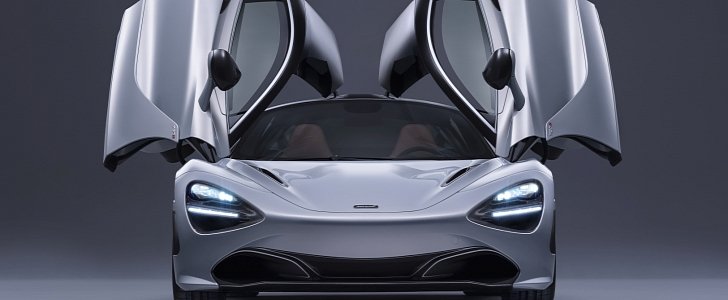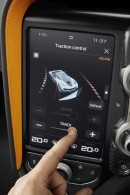The debut of the 720S doesn't just offer us a replacement for the 650S. That's because the newcomer marks a new era for McLaren, one that no longer sees Woking having to deal with the inevitable limitations of the MP4-12C it introduced when it returned to making road cars back in 2011.
Slotted in between the Sport Series (think: 570S) and the Ultimate Series (the retired P1 will be replaced by a hyper GT in 2019), the Super Series represented by the 720S refines itself as the British automaker grows mature.
It all starts with the air-hungry headlight assemblies, while the semi-hollow doors host air channels, helping the designers remove the hungry intakes on the sides of the beast.
The rear deck and the wing in particular beings the longtail image that became famous back in the day at Le Mans. For the wing, McLaren has turned to a trick we've met on the MSO HS, whose fixed element could also act as an air brake. To be more precise, the active wing of the 720 can play the air brake role even when raised.
The frunk is now accompanied by a storage space behind the seats that can swallow almost twice as much luggage, but, unlike in the case of the 570 GT, the rear window is fixed, so you'll have to flex your muscles a bit when loading the area behind the seats.
Oh, and let's not forget the rotating digital dashboard, which is ready to cater to both track and across-the-continent needs.
The change also means McLaren engineers have a complex task on their hands when it comes to developing the Spider incarnation of the 720S.
To get an idea of how far the carmaker has gone to boost the coziness factor of the supercar, we'll mention that the aluminum double wishbone suspension is new, while the brake rotors are smaller to reduce unsprung mass.
Don't worry, though, the brakes can deliver the same stopping power, while they have to work with less mass. A 40 lbs diet helps the 720S tip the scales at 2,829 lbs dry or 3,128 lbs wet.
McLaren has widened the rear track and played with the rubber: the rear tires come in a 305/30 R19 size, while the front ones are wider, coming in a 245/35 R19 size.
The Ricardo-supplied twin-turbo V8 at the middle of the thing has jumped from 3.8 to 4.0 liters. The stroked engine works with a pair of twin-scroll turbos, with the aim being to minimize the turbo lag, an aspect that was a bit of a drawback with the model's predecessors.
The output jumps from 650 hp and 500 lb-ft to 720 hp and 568 lb-ft, with an improvement also being delivered in the efficiency and emissions area.
If you're in the market for a supercar today, you'll be treated with the now-mature McLaren, the not-just-a-poser Lamborghini and Ferrari's twin-turbo return. Now all we need to do is wait and see what Porsche has prepared for the 911 GT2.
Check out the Instagram video below for a Geneva floor view of the Macca, while you can zoom in on the supercar's details using the image gallery to your right.
The styling
It all starts with the design area, where McLaren is unapologetic about its aero-dictated cues. Not every supercar aficionado will appreciate the shark appearance of the newcomer, but the aerodynamic implications are well hidden behind the Sheet-Moulded-Composite skin of the supercar.It all starts with the air-hungry headlight assemblies, while the semi-hollow doors host air channels, helping the designers remove the hungry intakes on the sides of the beast.
The rear deck and the wing in particular beings the longtail image that became famous back in the day at Le Mans. For the wing, McLaren has turned to a trick we've met on the MSO HS, whose fixed element could also act as an air brake. To be more precise, the active wing of the 720 can play the air brake role even when raised.
The cabin
McLaren had already accustomed us to placing the vehicle occupants close to each other and while this feature has been maintained, the cabin with has been slightly reduced. Even so, thanks to the overly generous greenhouse (more on this below) and the thinner dashboard (the approach was first introduced on the 570S), you get an airy feeling, so the 720S seems roomier than the car it replaces.The frunk is now accompanied by a storage space behind the seats that can swallow almost twice as much luggage, but, unlike in the case of the 570 GT, the rear window is fixed, so you'll have to flex your muscles a bit when loading the area behind the seats.
Oh, and let's not forget the rotating digital dashboard, which is ready to cater to both track and across-the-continent needs.
The carbon tub
We're looking at a new carbon tub, one that builds on the structure of its predecessor. So far, the carbon lower structure was matched to an aluminum superstructure, but the 720S gets an all-carbon layout. This allows for thin pillars, hence the generous glass sections found all around the vehicle. Moreover, with the doors cutting into the roof, access is more facile than ever.The change also means McLaren engineers have a complex task on their hands when it comes to developing the Spider incarnation of the 720S.
The 720S has a dual character
The early 12Cs were known for their brutal speed and limited road manners. With the 720S, the Brits aim to deliver a dual character, mixing track toy and Grand Tourer genes.To get an idea of how far the carmaker has gone to boost the coziness factor of the supercar, we'll mention that the aluminum double wishbone suspension is new, while the brake rotors are smaller to reduce unsprung mass.
Don't worry, though, the brakes can deliver the same stopping power, while they have to work with less mass. A 40 lbs diet helps the 720S tip the scales at 2,829 lbs dry or 3,128 lbs wet.
McLaren has widened the rear track and played with the rubber: the rear tires come in a 305/30 R19 size, while the front ones are wider, coming in a 245/35 R19 size.
The Ricardo-supplied twin-turbo V8 at the middle of the thing has jumped from 3.8 to 4.0 liters. The stroked engine works with a pair of twin-scroll turbos, with the aim being to minimize the turbo lag, an aspect that was a bit of a drawback with the model's predecessors.
The output jumps from 650 hp and 500 lb-ft to 720 hp and 568 lb-ft, with an improvement also being delivered in the efficiency and emissions area.
The performance numbers
The McLaren 720S only needs 2.9 seconds to cover the 0 to 62 mph sprint, while the 0-124 mph game takes 7.8 seconds. When it comes to the overly thrilling 0 to 186 mph sprint, the brute needs 21.4 seconds, while the quarter-mile run only takes 10.3 seconds (the last is a 0.2s improvement compared to the 650S performance). As for the maximum velocity of the animal, this sits at 212 mph.The market details
In the pricing department, the 720S comes with a 5 percent premium over the 650S, so its MSRP should be close to $280,000.If you're in the market for a supercar today, you'll be treated with the now-mature McLaren, the not-just-a-poser Lamborghini and Ferrari's twin-turbo return. Now all we need to do is wait and see what Porsche has prepared for the 911 GT2.
Check out the Instagram video below for a Geneva floor view of the Macca, while you can zoom in on the supercar's details using the image gallery to your right.
































